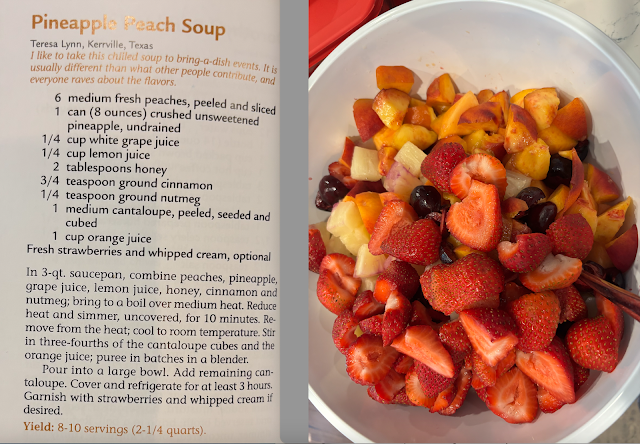Called Texas Delight by some, it’s the first dessert I ever made as a child. During the summers, I made it often! My family clipped the recipe from our newspaper under a different name. Pecans, Pudding, and Cream Cheese Delight is a delicious layered dessert well worth the effort and calories:
First Layer: Make an easy pecan crust:
1 cup of all-purpose flour
1 stick of soften butter
1 teaspoon cider vinegar (Vinegar is a gluten inhibitor that makes a flaky crust. Bakers call it their secret ingredient.)
1 cup of pecans - We left them whole, but feel free to break them up.
Directions for the crust, your 1st layer:
1) Mix the flour, butter and vinegar together and press the dough into a cake or square baking pan. I use a 9” by 9” pan. Press the pecans evenly into the dough.
2) Bake in a preheated 350 degrees F oven for 15 minutes. The dough will start to turn slightly brown. Remove and cool completely.
Second Layer:
1 package (8 ounces) cream cheese (or Neufchàgel cheese)
3/4 cup of powered sugar
1 cup of very cold whipped cream - We no longer eat Cool Whip, the original whipped topping in the recipe. If you can find a readymade healthy whipped cream topping made from real cream or milk at your supermarket you can use it for convenience. I have a recipe below for making 3 cups of real whipped cream* you can make first and keep in the freezer while making the dessert.
Dirctions for the 2nd layer:
3. Mix the cream cheese, powdered sugar and 1 cup of whipped cream together and spread it on the cold pecan crust. Place it in the refrigerator, the colder, the better.
Third Layer:
 Ingredients
Ingredients
2 packages of instant vanilla pudding
2 cups of cold milk
Directions for the 3rd layer:
4) Whip the dry pudding powder into the milk (a 2:2 ratio), mixing for 2 minutes. Spead the pudding over the cream cheese mixture.
Fourth Layer
2 cups of very cold whipped cream
1/2 cup of chopped pecans.
Directions for the 4th layer:
5) Spread the remaining 2 cups of whipped cream as a final 4th layer over the others and garnish with a half cup of chopped pecans.
6) Chill in the refrigerator until set. We always tried to wait at least 3 hours, the colder the better the taste!
Our recipe calls for instant vanilla pudding, but I see in allrecipes, the uploader uses instant coconut cream pudding mix, which I haven’t tried. I know the vanilla pudding is delicious. Nowadays I lighten the recipe with reduced fat cream cheese and milk in the pudding. But! Don’t be fooled, there’s still plenty of calories, and yet not as many as when I made it as a child.😝🌞
🥛🍶🍴🥛🍶🥛🍶🥛🍶🥛🍶🥛🍶🥛🍶🥛🍶🥛🍶🥛🍶
*How to make 3 cups of Real Whipped Cream:
Ingredients:
1 1/2 cups cold heavy (at least 36% fat) or whipping cream (30% - 36% fat). Either will whip into cream.
3 tablespoons sugar (granulated or powered)
1 1/2 teaspoon vanilla extract
Directions to make whipped cream:
1) Chill your mixing bowl and beaters in the freezer.
2) Add your heavy cream, sugar and vanilla extract. Begin mixing on a low speed and increase to medium. Mix until stiff peaks form.
Keep in the freezer while you make the dessert.
🥛🍶🍴🥛🍶🥛🍶🥛🍶🥛🍶🥛🍶🥛🍶🥛🍶🥛🍶🥛🍶
You may also enjoy:
















































